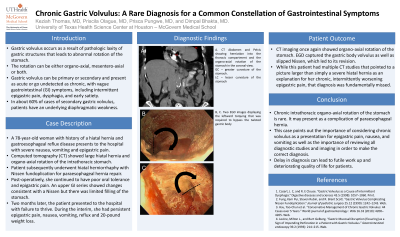Back


Poster Session D - Tuesday Morning
Category: Stomach
D0721 - Chronic Gastric Volvulus: A Rare Diagnosis for a Common Constellation of Gastrointestinal Symptoms
Tuesday, October 25, 2022
10:00 AM – 12:00 PM ET
Location: Crown Ballroom

Has Audio

Keziah Thomas, MD
UT HSC - Houston
Houston, Texas
Presenting Author(s)
Keziah Thomas, MD1, Priscila Olague, MD1, Prisca Pungwe, MD2, Dimpal Bhakta, MD1
1UT HSC - Houston, Houston, TX; 2Baylor College of Medicine, Houston, TX
Introduction: Gastric volvulus occurs as a result of pathologic laxity of gastric structures that leads to abnormal rotation of the stomach. The rotation can be either organo-axial, mesentero-axial or both. Gastric volvulus can be primary or secondary and present as acute or go undetected as chronic, with vague gastrointestinal (GI) symptoms, including intermittent epigastric pain, dysphagia, and early satiety. In about 60% of cases of secondary gastric volvulus, patients have an underlying diaphragmatic weakness. Delay in diagnosis can lead to futile work up and deteriorating quality of life for patients.
Case Description/Methods: A 78-year-old woman with history of a hiatal hernia and gastroesophageal reflux disease presents to the hospital with severe nausea, vomiting and epigastric pain. Computed tomography (CT) was notable for a large hiatal hernia and organo-axial rotation of the intrathoracic stomach. Patient subsequently underwent hiatal herniorrhaphy with Nissen fundoplication for paraesophageal hernia repair. Post-operatively, she continued to have poor oral tolerance and epigastric pain. An upper GI series showed changes consistent with a Nissen but there was limited filling of the stomach. An endoscopy (EGD) at that time showed severe ischemic gastropathy. She was placed on bowel rest with medical management and subsequent improvement in her symptoms. Two months later, the patient presented to the hospital with failure to thrive. During the interim, she had persistent epigastric pain, nausea, vomiting, reflux and 20-pound weight loss. CT imaging once again showed organo-axial rotation of the stomach. Repeat upper GI series did not show changes consistent with a volvulus but the procedure was incomplete due to patient intolerance. Remarkably, EGD captured the gastric body volvulus as well as slipped Nissen, which led to its revision. While this patient had multiple CT studies that pointed to a picture larger than simply a severe hiatal hernia as an explanation for her chronic, intermittently worsening epigastric pain, that diagnosis was fundamentally missed.
Discussion: Chronic intrathoracic organo-axial rotation of the stomach is rare. It may present as a complication of paraesophageal hernia. This case points out the importance of considering chronic volvulus as a presentation for epigastric pain, nausea, and vomiting as well as the importance of reviewing all diagnostic studies and imaging in order to make the correct diagnosis.

Disclosures:
Keziah Thomas, MD1, Priscila Olague, MD1, Prisca Pungwe, MD2, Dimpal Bhakta, MD1. D0721 - Chronic Gastric Volvulus: A Rare Diagnosis for a Common Constellation of Gastrointestinal Symptoms, ACG 2022 Annual Scientific Meeting Abstracts. Charlotte, NC: American College of Gastroenterology.
1UT HSC - Houston, Houston, TX; 2Baylor College of Medicine, Houston, TX
Introduction: Gastric volvulus occurs as a result of pathologic laxity of gastric structures that leads to abnormal rotation of the stomach. The rotation can be either organo-axial, mesentero-axial or both. Gastric volvulus can be primary or secondary and present as acute or go undetected as chronic, with vague gastrointestinal (GI) symptoms, including intermittent epigastric pain, dysphagia, and early satiety. In about 60% of cases of secondary gastric volvulus, patients have an underlying diaphragmatic weakness. Delay in diagnosis can lead to futile work up and deteriorating quality of life for patients.
Case Description/Methods: A 78-year-old woman with history of a hiatal hernia and gastroesophageal reflux disease presents to the hospital with severe nausea, vomiting and epigastric pain. Computed tomography (CT) was notable for a large hiatal hernia and organo-axial rotation of the intrathoracic stomach. Patient subsequently underwent hiatal herniorrhaphy with Nissen fundoplication for paraesophageal hernia repair. Post-operatively, she continued to have poor oral tolerance and epigastric pain. An upper GI series showed changes consistent with a Nissen but there was limited filling of the stomach. An endoscopy (EGD) at that time showed severe ischemic gastropathy. She was placed on bowel rest with medical management and subsequent improvement in her symptoms. Two months later, the patient presented to the hospital with failure to thrive. During the interim, she had persistent epigastric pain, nausea, vomiting, reflux and 20-pound weight loss. CT imaging once again showed organo-axial rotation of the stomach. Repeat upper GI series did not show changes consistent with a volvulus but the procedure was incomplete due to patient intolerance. Remarkably, EGD captured the gastric body volvulus as well as slipped Nissen, which led to its revision. While this patient had multiple CT studies that pointed to a picture larger than simply a severe hiatal hernia as an explanation for her chronic, intermittently worsening epigastric pain, that diagnosis was fundamentally missed.
Discussion: Chronic intrathoracic organo-axial rotation of the stomach is rare. It may present as a complication of paraesophageal hernia. This case points out the importance of considering chronic volvulus as a presentation for epigastric pain, nausea, and vomiting as well as the importance of reviewing all diagnostic studies and imaging in order to make the correct diagnosis.

Figure: Part a. CT Abdomen and Pelvis showing herniation of the stomach into the thoracic compartment and the organo-axial rotation in the coronal view. LC - lesser curvature of the stomach and GC - greater curvature of the stomach
Part b and c. EGD showing the leftward torquing required to bypass the twisted gastric body.
Part b and c. EGD showing the leftward torquing required to bypass the twisted gastric body.
Disclosures:
Keziah Thomas indicated no relevant financial relationships.
Priscila Olague indicated no relevant financial relationships.
Prisca Pungwe indicated no relevant financial relationships.
Dimpal Bhakta indicated no relevant financial relationships.
Keziah Thomas, MD1, Priscila Olague, MD1, Prisca Pungwe, MD2, Dimpal Bhakta, MD1. D0721 - Chronic Gastric Volvulus: A Rare Diagnosis for a Common Constellation of Gastrointestinal Symptoms, ACG 2022 Annual Scientific Meeting Abstracts. Charlotte, NC: American College of Gastroenterology.
